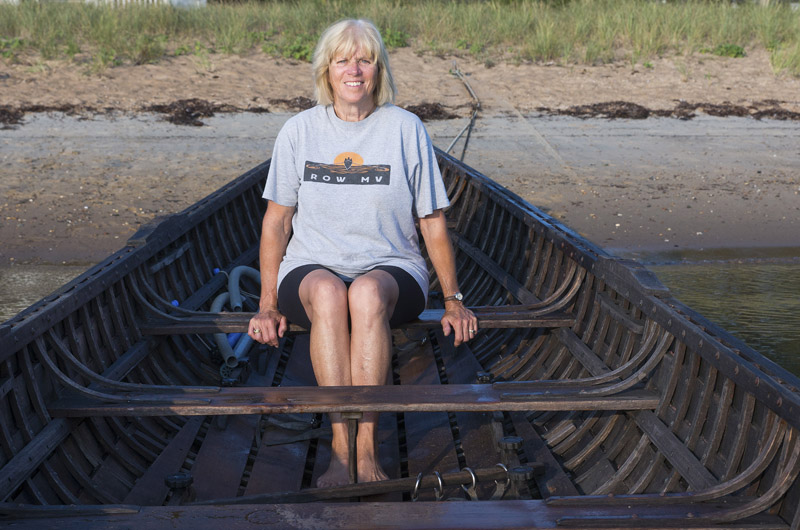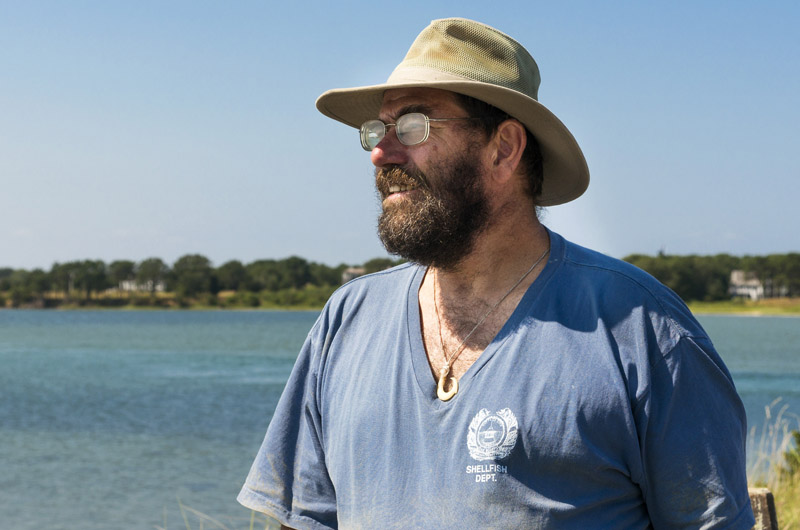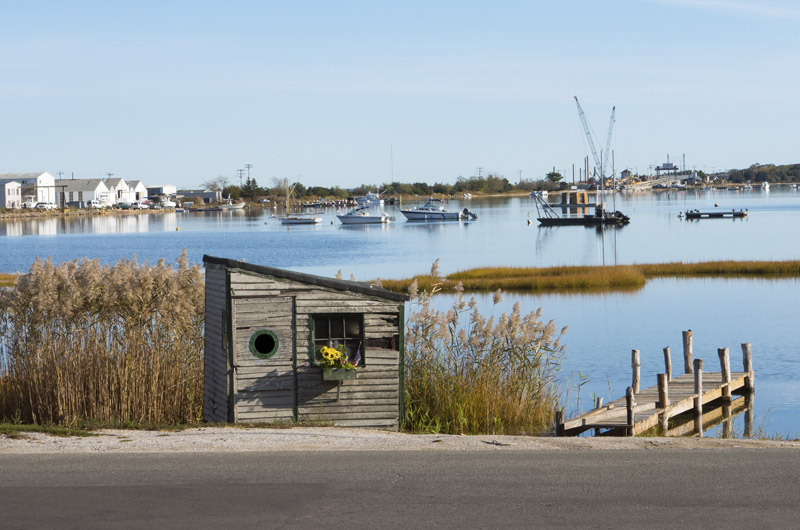A small handful of scientists this week were at work on Squibnocket and Menemsha ponds recovering tide gauges and other instruments that have been collecting data over the last few weeks.
The two up-Island ponds are among the last to be studied by the Massachusetts Estuaries Project, a unique partnership between the University of Massachusetts School of Marine Science and Technology and the Department of Environmental Protection that emerged around 2002 to help preserve coastal waters in the state.
Each MEP report — there have been about 60 so far — profiles an estuary’s hydrodynamics, watershed land uses and other features. The DEP then develops a total maximum daily load for nitrogen entering each system. Nearly every coastal pond in the state has exceeded its budget, setting the stage for algae blooms and a widespread decline in pond health.
Most of the nitrogen flowing into Island ponds comes from septic tanks, but runoff and acid rain also contribute to the problem. Federal regulations surrounding runoff and septic tanks are a matter of dispute, but with guidance from the MEP, many towns are eager to monitor total maximum daily loads on their own.
The state university marine science division had been providing nitrogen thresholds for towns since before 2000, in response to a growing concern over pond water quality. By partnering with the DEP, it was able to provide a consistent starting point for towns to seek permits and develop wastewater management plans.
The MEP originally set out to study 89 estuaries in the state, but with delays and limited funding, the number was cut back to 70 in 2009. Towns, counties and the state have shared the cost of the reports, easing the financial burden all around. About $12.5 million in total has been spent on the project since 2002.
Towns unwilling or unable to pay their share of the cost were cut from the estuaries project docket. But in many cases the project has raised awareness of the nitrogen problem and spurred action at the town and regional levels.
“It has certainly added a lot of complexity to our understanding of these estuaries, and by its very nature it’s caused us to pay more attention to how we can improve,” Tisbury selectman and wastewater commissioner Melinda Loberg said.
Since receiving the MEP report for Lagoon Pond in 2008, Tisbury has begun the process of expanding its sewage treatment capacity and exploring its options for wastewater regulation. Along with Oak Bluffs, it has also formed the Island’s first joint watershed planning district for the Lagoon, which is split evenly between the towns.
The MEP has issued reports for 12 Island water bodies. In addition to Squibnocket and Menemsha ponds, all the data for several ponds in Edgartown has been collected.
Lagoon Pond and Lake Tashmoo, whose watersheds extend into multiple towns, are among the more impaired on the Vineyard. In both cases, the solutions will need to focus on wastewater, since septic systems account for about 70 per cent of the nitrogen loads.
It’s a similar story for most of the 53 estuaries on the Cape, although most of those are generally worse off as a result of widespread development over the years.
Paul Niedzwiecki, director of the Cape Cod Commission, believes the MEP has been essential in raising awareness and helping set a course for action on the Cape. “It allows you to tailor solutions that are much more targeted, because you know a lot more about how the hydrogeology is working and where the problems are coming from,” he said.
He added that without the estuaries project, if the state ever mandates compliance with total maximum daily loads, solutions would likely default to sewering, which is a more proven technique for removing nitrogen from wastewater. “That’s enough to be incredibly expensive and not really efficient,” Mr. Niedzwiecki said. “Knowing in more detail through the MEP what the major problems are and where they are coming from allows you to build more efficient solutions.”
MEP, Town by Town
The estuaries project has meant different things to different towns.
In Chilmark, where lower housing density would make sewering impractical, the goal in commissioning MEP studies was simply to obtain a baseline for better pond management. And much of the nitrogen in Chilmark and Tisbury Great Ponds, according to the reports, comes from agricultural runoff, along with wastewater.
“We went into this thinking that the DEP is only concerned about sewering,” Chilmark executive secretary Tim Carroll said. “Even the state realized that sewering in rural communities like Chilmark doesn’t make sense.”
But he also welcomed the MEP’s recommendation for more regular and frequent openings of the ponds to the sea, a process that is often complicated by environmental regulations, storms and other factors.
Mostly as a result of nitrogen loading, few if any ponds on the Cape and Islands comply with the federal Clean Water Act of 1972, which required states to assign total maximum daily loads — called TMDLs in planning parlance— to waters they identify as impaired.
The state requires wastewater permits for water that flows from a pipe or other discrete source into a water body. But Massachusetts does not interpret the Clean Water Act as requiring permits for wastewater that first enters the ground, including runoff and the effluent from septic systems. So managing those sources has fallen largely to the towns.
MEP director Brian Howes said this week that the project is entering a new phase, focused more on monitoring and implementation. He did not believe that the question of state enforcement would be a significant roadblock, and said the question may even be beside the point.
“Towns are supposed to work towards cleaning up whether it’s a point source or non-point source contaminant,” he said, speaking of the Clean Water Act. “If a town is not cleaning things up they are going to hear it from their citizens.”
Among other things, Mr. Howes is working with five towns on the Cape, including Falmouth, Orleans and Barnstable (the others were still confidential) in tracking the effect of aquaculture, since shellfish are known to absorb nitrogen from the water. But the DEP has yet to officially recognize that as a viable strategy that can earn nitrogen credits.
Major aquaculture programs are also underway on both sides of Sengekontacket Pond (in Oak Bluffs and Edgartown), along with experimental oyster beds in the Lagoon.
Sheri Caseau, water resource planner for the Martha’s Vineyard Commission, was one of the scientists helping to remove instruments from the up-Island ponds this week.
“Sewering is always the fallback,” she said. “But we’d like to see other things available other than just that.”
The DEP has indicated that it is willing to work with Island towns that want to pursue aquaculture as a mitigation technique, as long as the nitrogen levels are going down.
“It’s basically a question of proving the efficacy of these different alternatives,” said DEP engineer Brian Dudley, who oversees the estuaries project. “If it’s backed up with data, with an approved monitoring program, and it’s something that we believe is sustainable, then yes, we can certainly consider nitrogen credits in those situations.”
The MEP has run detailed scenarios for sewering and freshwater attenuation around Lagoon Pond in Oak Bluffs and Vineyard Haven, which may help those towns come up with the most efficient and cost-effective solutions to meet the total maximum daily load. But the studies come with a price tag. Among other things, the MVC plans to work with towns and with the MEP to identify viable options and track the solutions.
Politics, Economics, the Law
In the next phase of the MEP, the DEP will likely take a back seat, Mr. Howes said. He suggested that the program had been something of a handful for the state agency, since its progress depended so much on town meeting support, public funding and other variables. “It was a rough project for them to manage,” he said.
Funding in the new phase will rely mostly on taxpayer support and university funding.
Ms. Caseau did not expect much state funding to be available to the Island for nitrogen mitigation. But she believed state revolving fund loans, along with federal grants, could help pay for the solutions.
Among other things, the MEP has shed light on the limits of state enforcement when it comes to total maximum daily loads. As one consequence of the project, the Conservation Law Foundation, a national advocacy group based in New England, sued the EPA in 2013, arguing that its approval of the TMDLs had fallen short of Clean Water Act requirements by not subjecting septic tanks, storm water and other nitrogen sources to state permitting.
“Our argument is that it’s point-source pollution,” said Chris Kilian, director of the CLF’s Clean Water and Healthy Forests Program, noting that the flow of groundwater into surface waters is well documented on the Cape. “Once something falls within the definition of point-source it requires a permit under the Clean Water Act.”
A second lawsuit argued that the Cape Cod Commission had failed to update its regional wastewater plan as required under section 208 of the federal act. The last update was in the 1970s.
The judge dismissed the first case on standing grounds, but agreed that the so-called 208 plan was in need of an update. The state allocated about $3 million for an updated plan and a settlement was reached last year. The EPA approved the plan in September.
Among other things, the plan highlights the need for towns to collaborate on solutions, since watersheds often cross town boundaries. On the Vineyard, more than half the 24 major estuaries cross as least one town line.
Mr. Kilian noted that towns on the Cape have tuned in to the nitrogen problem, at least partly for its potential effect on the local economy. “They want to own it, they want to go it alone,” he said. “But they are all complaining about how much it’s going to cost, the complexity and the difficulty politically, and the economics of the whole situation.”
The Cape has until next June to make progress on the plan. “The next nine months are going to be critical to see whether the towns can come up with a program that would actually meet the requirements of the law,” Mr. Kilian said.
Tailoring Solutions for the Vineyard
The Vineyard has no 208 plan, although the EPA has indicated that a study by the environmental engineering firm Wright Pierce in 2010 could serve as a framework. But Ms. Caseau suggested that the Island may be better off without a 208 plan, noting that on the Cape the planning process alone cost millions.
“We have a lot of ideas already,” she said of the Island communities. “So rather than put our money in a management plan, we might start implementing some of those things we found in other studies.”
Others agreed that some flexibility in the process would benefit remediation efforts.
“You could set up water districts so that [people] would have to deal with the permit issues,” Mr. Howes said, noting one option for enforcement. “But in reality the planning that’s going on to meet these targets for estuarine restoration does all that without everybody having to file paperwork on their septic system every year.”
Flexibility may also allow towns to pursue less-proven options such as aquaculture, permeable reactive barriers (which could remove nitrogen from groundwater through chemical processes) and constructed wetlands. “These are hard solutions that can be done, and they can save the towns 30, 40 per cent or more of the cost,” Mr. Howes said. He and others hinted that the state could still exert its influence by withholding wastewater-related funds from communities that do not work toward the TMDLs. But as long as towns are pursuing solutions, he does not believe enforcement will be an issue.
Others believe that state-mandated compliance is only a matter of time.
“We expect that down the road, that’s what they are going to do,” Mrs. Loberg said. “When they finish all of the reports they are going to move more and more towards making this a mandatory objective. But I get the feeling that they are not going to get punitive unless a town doesn’t make progress. And we’re already making progress.”
Mr. Niedzwiecki believes the Cape has largely satisfied public concerns about the problem and also possible solutions. “So the problem moving forward is going to be money,” he said. “That’s always the crux of it. If sewers were free we wouldn’t be having this discussion.”
The Cape’s 208 plan may not officially apply to the Vineyard, but there is much the Island can learn from the process. Among other things, the Cape spent hundreds of thousands of dollars developing a software modeling program that allows communities to plug in various scenarios to see how much nitrogen they would remove and what it would cost.
“I think what we’ve built over here will be very easily transferrable to the Vineyard,” Mr. Niedzwieki said.
Time is also a factor. Even if all the technical reports were filed and daily limits were available today, it could still take years for towns to adopt solutions and see results. With most of the TMDLs already drafted, however, the towns can begin planning around information the state may use in its permitting decisions for years to come.
Despite the many delays over the years and the various hurdles to clear, Mr. Howes remains optimistic that the MEP and local efforts will pay off.
“Now we’re not arguing about basic stuff,” he said. “Now we argue about how we’re going to solve this problem.”
This is the last in a series. All the stories in the Coastal Ponds Under Pressure project appear at vineyardgazette.com/ponds.











Comments (2)
Comments
Comment policy »